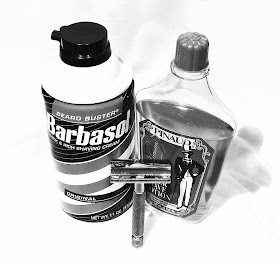To truly enjoy a family of fragrances, it's useful to revisit the first in a genre, that which spawned dozens of variations, the "originator." For most of the early twentieth century, European and American men wore traditional fougères, things like Fougère Royale, English Lavender, Dunhill, Pour un Homme, Moustache, and Arden's Sandalwood. In the early sixties the old guard began to transmogrify into the newer and more novel, due in large part to the invention of better fragrance molecules. Things like Brut and Agua Brava, with fifties-era nitro-musks and transcendent 10 carbon alcohols, were tailored to be rich, brash, and smelled the way the Rolling Stones played.
Then came refinement, and its name was Paco. Anything's possible, but I like to imagine the pre-game for selling the concept to the perfumer. "We like traditional Spanish ferns, and also the scent of Barbasol. Make it a little of both." Or, per Tom Ford, "Make it so."
Paco Rabanne Pour Homme is the premiere mass-market mega-hit aromatic fougère, and as such received accolades and suffered the outrageous fortune of having many pursuant releases improve what it first proposed: a fresh, sweet, woody-green fougère, capable of commanding respect without raising its voice. Paco gathered the familiar shaving-soap smells of every man's morning ablutions and distilled them down to a magnificent heart accord, which by all rights should be bolstered by two or three more aromatics and turned into a old-school perfumer's base (which then should promptly be sold to whoever makes Pinaud's aftershaves).
The beauty of the heart is in its bold blend of oakmoss, coumarin, and a notably polite sage, which segregate over time into their sheer myrcene, myrcenol, rhodinal, aniba rosaeodora, and pelargonium constituencies. (This translates to bay leaf, lavender, citron, rosewood, and geranium.) Smell it up close, and the citrus note smells tart and bright, wedded nicely to sweet English lavender, with the herbs lighting the floral bay and spiced rosewood's subtle shadows. Kind of like an evening stroll through the autumn woods. From afar, I get a much less saturnine smell: shaving cream. Very nice.
My gripe with Paco is that it needs a spirit level. Its stages are all beautiful and deceptively complex, but I've ridden Japanese jeeps with smoother transmissions. Paco's bright, crisp, ebulliently-green top accord is the sort of thing one encounters only four or five times in a lifetime of smelling hundreds, if not thousands of perfumes. That it only lasts ten seconds is a travesty. Fortunately its lavender lives on to freshen the proceedings and hold their components together, as lavender typically does in masculine compositions, but from this forest-glen emerges a bubble of sweetness, the slightly-bitter nuttiness of coumarin flanked by honey. Together they form an accord that should send every dentist within a thirty miles radius on high alert.
This shit is sweet. I'd say it's definitely too sweet, but then again, it's a variant of traditional fern, which was reputedly quite sweet at heart, with stray tonka and hay accords amplifying rich coumarin effects. So maybe Paco's coumarin, heady and sugary as it is, really isn't out of place, but just way out there, the man at the wedding in the robin's-egg blue seersucker and paper pants. The rapidity of transition in this fragrance is a mixed blessing - here it allows the sugar rush to pass within ten minutes, and from there it's cool, woody-dusty goodness, with vibrant green accents.
Has Paco been eclipsed by its successors? Have Azzaro, Drakkar, and Rive Gauche taken the same floor plan and used better furniture? Yes and no. I find Azzaro tedious on a good day, although its earlier incarnations smelled captivating. But wearing it made me wonder if I wasn't taking myself too seriously. Drakkar is beautiful, perhaps the freshest mossy lavender on a bed of evergreens since Polo. I enjoy it, but wonder if it isn't taking itself too seriously. Things like Rive Gauche are merely variants, extensions of the barbershop wet-shaver aura peddled by Pinaud's Clubman, all the way up through history to Brut and Paco. YSL's version keeps the original furniture and re-upholsters it in black velour. Nice, but nothing new.
Maybe the most refreshing thing about Paco Rabanne is that it holds its best facets out where they belong: in a cool, musky sillage at five paces. Everything since has re-hashed and repeated the same structure, with negligible results. The aromatic fougère is dead; Long live Paco Rabanne Pour Homme!





















